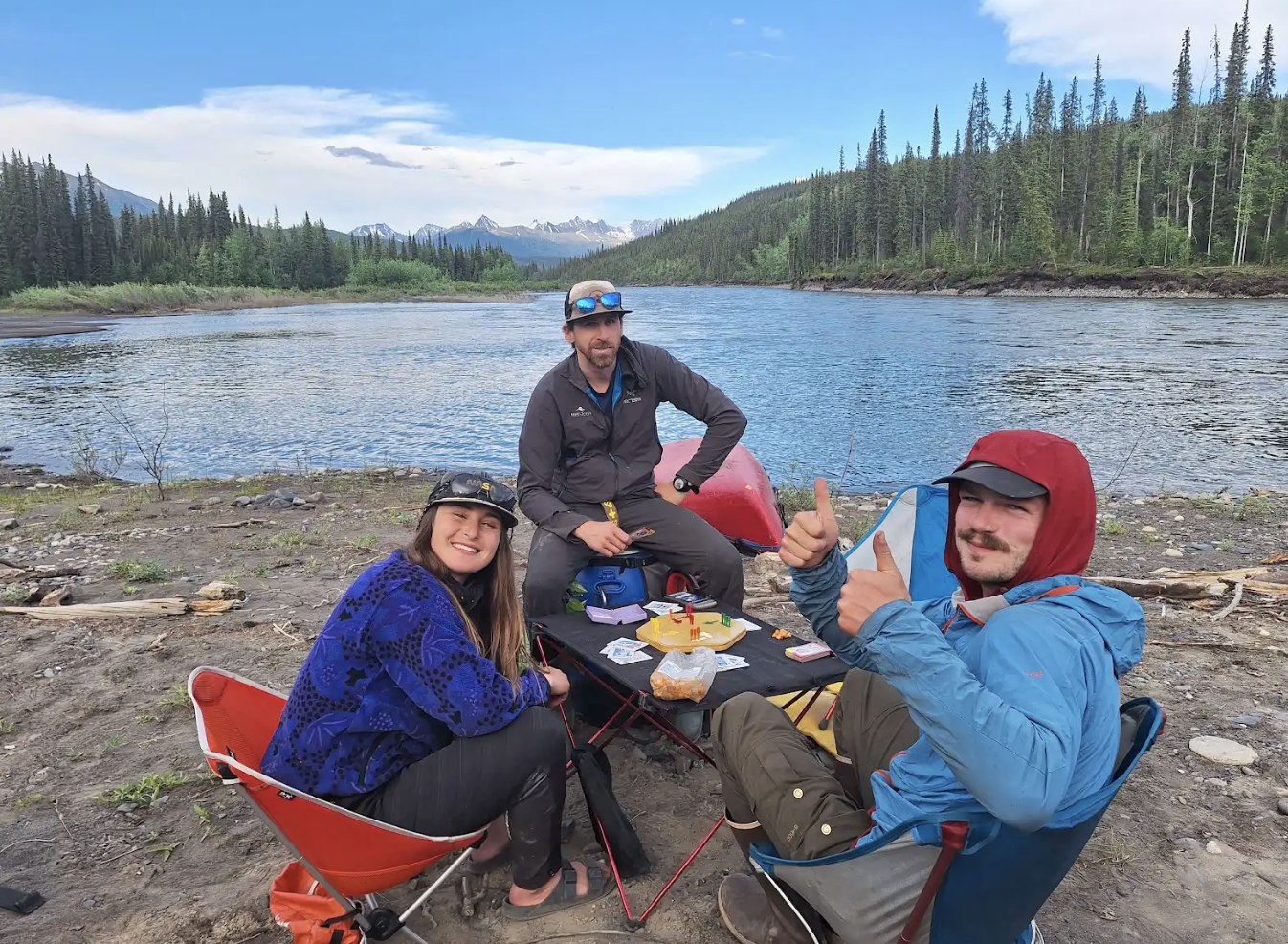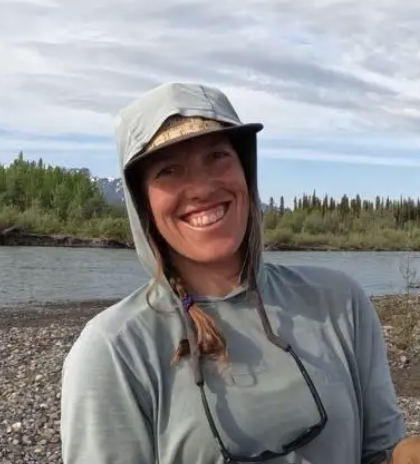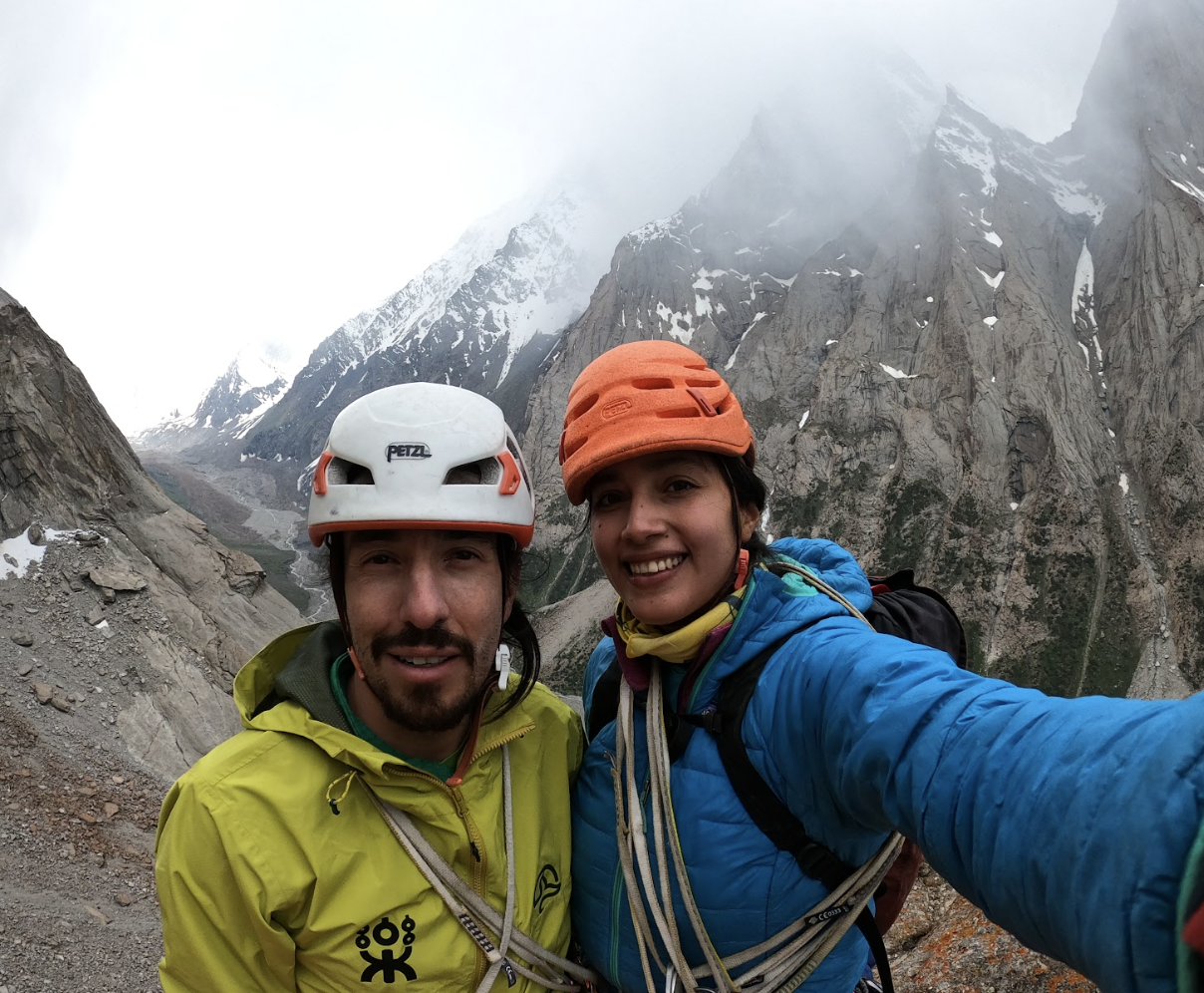The best way to travel down river is in a canoe with friends, with lots of water, and in the midnight summer. Read more to learn about NOLS instructor Rianna and her trip down the Hess River in the Yukon.
 Paddling through some fun and splashy waves.
Paddling through some fun and splashy waves.
For work these days, I do a lot of expedition canoeing both in education and guiding, and lots of river rescue. Some of this work is through NOLS, but more is up in Canada with MHO Adventures and Boreal River Rescue. I spend most days from mid-April to the end of September on the river for work and any chance I get, I paddle for myself. In the past, I have done trips for myself at the end of the season when the work slows down.
To be able to expedition with friends who also guide and instruct is a dream. Travel is easy and seamless, camp tasks are simplified, and paddling challenging whitewater can be really exciting. In September 2022, five friends and I did the Broadback River in Quebec. We all had epic seasons and came on the trip being pretty broken and really over camping, and then it rained a lot. It was still a spectacular trip. We were all just really tired and slept a lot. Remembering this, I made it a goal for my next canoe expedition to be earlier in the season, when we are fresh, when the weather is warm, and the days are long.

 Campsite night 4: Looking at maps, prepping for the next days with epic view.
Campsite night 4: Looking at maps, prepping for the next days with epic view.
Adjusting work schedules and saying “no” to some contracts was challenging as our season as Canadian river guides is very short. But we all committed, and on June 14th, three friends and I flew into Whitehorse to meet NOLS instructor Julia McGoey who helped us with shuttling, gear, and being our emergency contact. Julia was also the one who encouraged me to come work for NOLS when I first came to the Yukon.
About 8 years later she helped us get to the float-plane dock in Mayo. With two canoes and 12 days' worth of food, we flew into Porter Puddle in the middle of the Yukon, Canada. We portaged 1km through the dense dwarf birch to get to the headwaters of the Hess River. Our first two days were in the alpine, winding around tight bends, taking in the mountain views, and scouting for wildlife: beavers, moose, caribou, and bear. On day three, the whitewater began with some fun wave trains and eddies-hopping. It quickly escalated into continuous big-volume whitewater with large waves, pour-overs, and fewer eddies. We eddy-hopped our way down, only making moves we were confident in doing and then lining boats between moves we were uncomfortable with.
 Lining Rapid 1.
Lining Rapid 1.
 All of us working together to line down a technical section of whitewater, using ropes and current to safely maneuver our boats down.
All of us working together to line down a technical section of whitewater, using ropes and current to safely maneuver our boats down.
 Greg in the bow paddling after lining for 200m.
Greg in the bow paddling after lining for 200m.
When I did this river in 2017 as a student on my NOLS instructor course, I remember this day being a lot of fun and being excited about catching eddies, not really thinking about safety and what would happen and how we would manage if a boat would tip. On this trip, we had much higher water, spray decks, four skilled boaters, and more river wisdom than 8 years prior, and still, we had to really think about safety and problem-solving. If a boat capsized and went downstream we would not be able to chase it. It was a big learning experience for my friend Ayden, who is a very skilled kayaker and has done only one other canoe trip which was down the Grand Canyon of the Colorado — also a big-volume river but the rapids end in a pool/flat water where you can collect and rescue if someone tips. Ayden was able to see the line that we could paddle and the moves that we had to make but then realized that the consequence of tipping on a continuous river was so high it was not actually in our acceptable level of risk to paddle. We needed to line instead, which she had never really done before!
I had this moment on my instructor course as a student and frequently with NOLS students on the river too. It’s when we see a line to paddle and we want to paddle, but because of the consequence or likelihood of tipping and where our current skill level is, it is too dangerous to paddle. Instead, we have to line or portage. Then we teach lining, which is actually a really fun way to move a canoe down the river. It involves teamwork, problem-solving, and reading the river to help you efficiently move boats safely downstream.
Pat paddling hard to make it through some big boily waves.
 One of the most beautiful canyons with big water eddy turns.
One of the most beautiful canyons with big water eddy turns.
After a day of this eddy hopping and lining, we paddled a day of pretty continuous fun and splashy rapids. The river then continued to move quickly with breaks of epic canyons filled with spicy eddies to catch, wave trains to both avoid and run straight through, bus-sized waves to avoid, and more epic views to take in.
We ate amazing meals, played cards, had a beach vacation, and paddled 100 km in 16 hours on our last day to finish the trip. It truly felt like a privilege to be on the Hess again with great friends. Some might not agree but I really believe that the best way to travel down a river is in a tandem canoe. They move fast on the flats and can be carried over land easily enough, they carry lots of gear, and they involve skill and teamwork to paddle beautiful lines through rapids. There is something spectacular about paddling a chosen line through a rapid and perfectly turning into the eddy at the bottom, bone dry, and being able to celebrate the success with your paddling partner. No other craft can have that shared experience of making moves like that together. Then after paddling steezy (stylish and easy) lines and catching eddies and jet ferries all day, you arrive at camp and flip your canoe over to create the perfect countertop to prepare your fire-cooked lasagna. It is truly the best.
Making calzones at the canoe table.
 Beautiful morning light as we embarked on our 100km day.
Beautiful morning light as we embarked on our 100km day.

We found this caribou shed and couldn’t resist carrying it for a little bit.
The Rothberg-Birdwhistell Expedition Fund was established by the Rothberg-Birdwhistell family to support NOLS Instructors as they design and execute personal wilderness expeditions.
Written By
Rianna Sterk
Rianna has been a NOLS instructor since 2018, focused mostly on whitewater canoeing. She also works as a canoe guide and Instructor trainer with MHO Adventures leading their River Roots Program, as well as teaching river rescue with Boreal River Rescue. She lives on the Ottawa River in Ontario, Canada. She spends her days kayaking and mountain biking, cross country skiing, gardening, and quilting. She loves nachos and games nights with friends and family.





